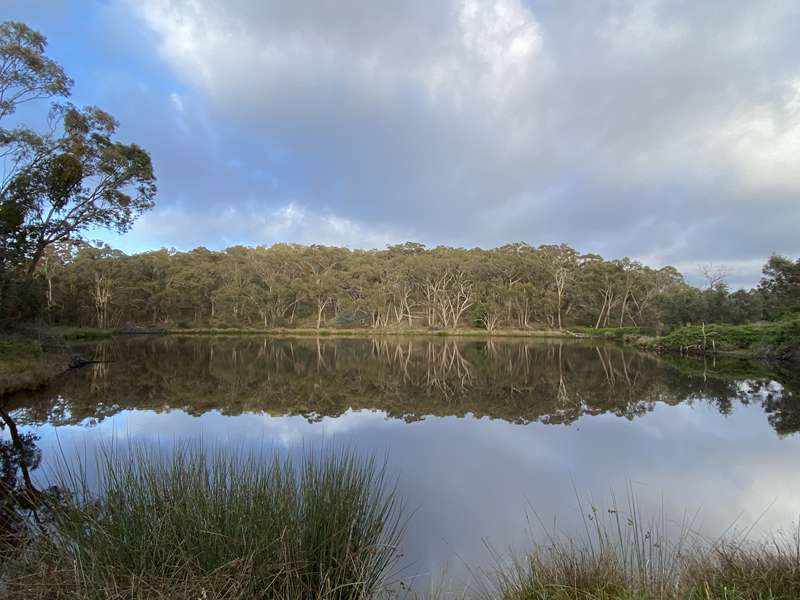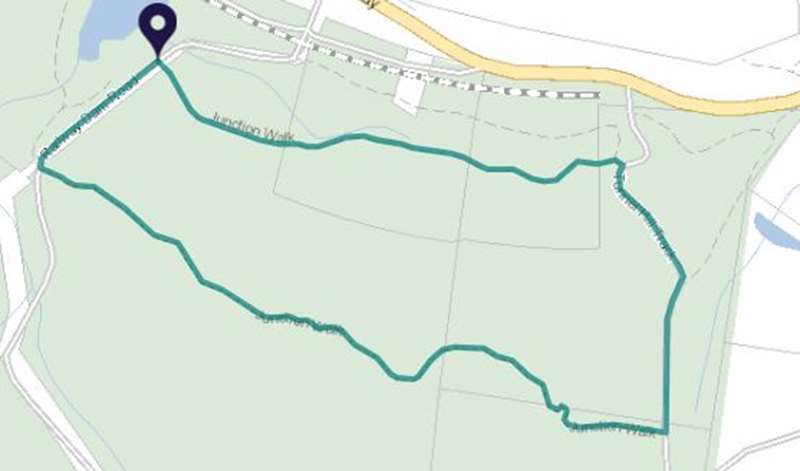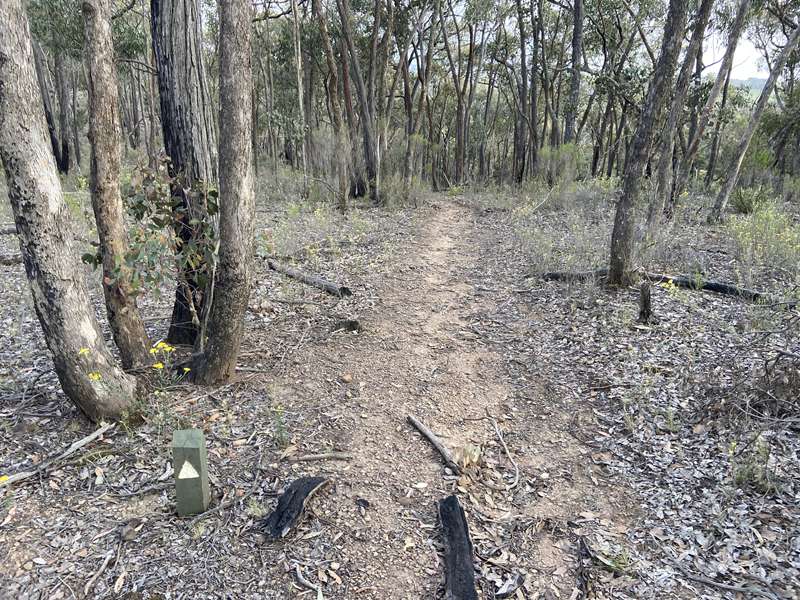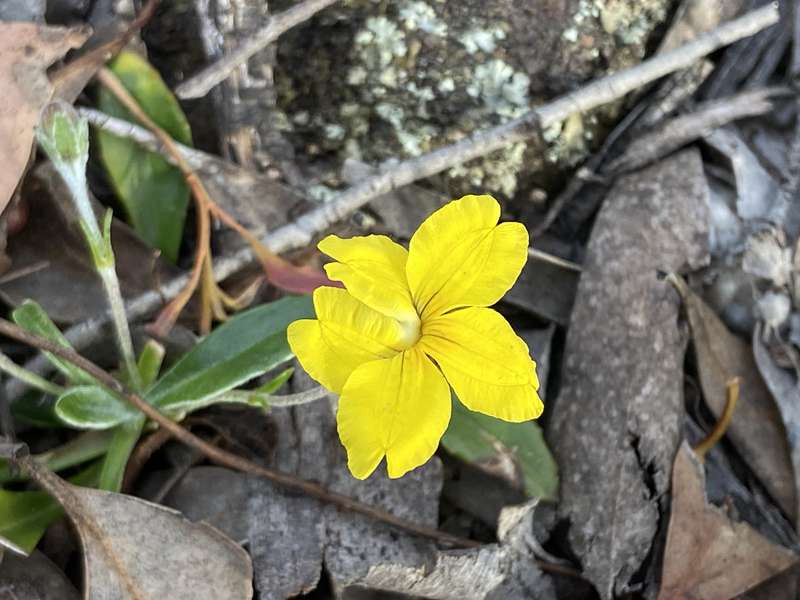Chewton - The Junction Walk


Immerse yourself in history on this easy 2.5km loop walk around a historic site in the Fryers Range State Forest.
The walk has occasional steps, short steep hills, formed track with some obstacles and is clearly sign posted.
The Junction in Fryers Range State Forest was once a busy route used by Traditional Owners and later by European settlers traveling to Castlemaine from Melbourne.
The Junction Walk starts at the Railway Dam and is an easy route around this historic site.
Remnants of a once-busy town
The Junction Hotel opened here in 1854 and was a popular resting point for travellers. Later mullock - waste matter - from the railway tunnel buried the hotel. During construction of the railway, a temporary town was established for construction crews and the Railway Dam was built to service steam trains.
The intricate stone stump on the bottom of the dam and the cobbled stone roads were made by the 200 German stonemasons who worked in the area.
On the walk you may find remnants of old buildings and see the footings of the old bridge on the original road to Fryerstown.
The Junction Walk Map

Access for Dogs:
Dogs are permitted on leash.
Review:
An nice walk through bushland which passes through a historical gold mining area, although we didn't manage to find much in the way of physical remnants of this time.
The first point of call is the Railway Dam. Admire the scenery of the dam because half of the dam edge is covered in thick blackberries and there is no easy / pleasant walk to walk around the dam.
Directly across the track from the dam is the start of the walk which is well signposted. The first section runs parallel to the Pyrenees Highway and there is some noise from cars.
Along the track there are a number of information signs with metal covers on local animals and native plants (see below).
After walking along the track through the bush, you will come to Tunnel Hill Track. Turn right and follow the road uphill until you see a sign 'Junction Walk' on the right. Follow the ridge line and you will come to a little pole with an arrow which indicates the track branches to the right and becomes narrower. We missed this sign and continued on for a while until the track petered out and had to retrace our steps.

This part of the walk is the nicest section. In Spring there were lots of yellow flowers. The path is a little rocky so be careful not to twist an ankle. The track later splits and follow the left track as per the direction arrow. This track reaches Railway Dam Road where you turn right and return to the starting point.

Information Signs

LOCAL ANIMALS
Fryers Range State Forest is home to many native animals including:
Mammals Ranging from large ground-dwelling species, like the Black Wallaby and the Eastern Grey Kangaroo, to nocturnal species that can crawl, climb and fly through their forest playground such as the Gould's Wattle Bat and the Sugar Glider. Most of these animals are herbivores (plant eating) or insectivores (insect eating) and help control insect numbers in the area.
Birds There are many bird species living in the forest, some soar above the canopy, often picking out their next prey, such as the Brown Falcon and Goshawks. Others dart between trees, feeding mostly on insects and nectar from medium to tall trees and some may spend more time on the ground. Birds, such as the Rufous Whistler, Golden, Whistler, Crimson Rosellas, Musk Lorikeet and Eastern Rosellas, add vibrant colour to the bush. You may also hear a range of different bird calls on your walk, they may be chirping or screeching, laughing or singing melodically. The colours, sounds and acrobatics of native bird species are often highlights of any bushwalk.
Reptiles and Amphibians Watch for Eastern Bearded Dragons, skinks and other snakes warming themselves in sunny spots on the track or rocky outcrops. Near water bodies you may hear male calls of the Brown Toadlet from February to June and the Common Froglet all year round.
Threatened Animals Fryers Range State Forest is home to a number of threatened species including the Brown Toadlet, Common Bent-wing Bat, Grey Goshawk, Brown Treecreeper and the Spotted Quail-thrush. To help protect these threatened species please do not litter and always treat the bush with respect.
How many different bird calls can you hear on your walk?
Have you seen any lizard or kangaroo tracks across the path?
NATIVE PLANTS
Fryers Range State Forest is home to over 350 native plant species
Dominant tree species of the area include Red Stringybark, Red Box, Yellow Box and Grey Box. Where these species occur depends on the soils, aspect and history of the area. For example, in the moister gullies you will mostly find Yellow Box which produces good quality firewood and honey. On the other hand Red Box and Red Stringybark occur on the exposed slopes and ridgetops and Grey Box trees grow on low, undulating hills.
A healthy forest needs trees of all ages and sizes to provide valuable habitat for other organisms. For example many birds house their young in hollows of old trees but others may hide away in smaller shrubs.
Below the eucalypt canopy is a wide variety of understorey plants. Smaller trees like Golden Wattle and Silver Wattle and shrubs like Cranberry Heath and Gold-dust Wattle attract birds and insects with colour, nectar and shelter. The forest floor is decorated with herbaceous (non-woody) wildflowers such as Twining Fringe-lilies, billy-buttons and native orchids, many of these explode with colour throughout spring.
Fryers Range State Forest also provides a suitable haven for threatened and protected species such as Fryerstown Grevillea, Pale Hickory Wattle and orchid species. Native orchids are very diverse and have special habitat requirements. To grow in the Australian bush they need to live closely with particular root fungi to obtain nutrients, have specific pollinators visiting them to produce seed for the following season, and some even need warm, still days to open their flowers, such as the sun-orchids.
A BUSY PLACE
It may be hard to imagine but the Junction would have been a busy spot in the early days, as it was the only safe road in and out of Fryerstown. Traffic to and from Melbourne as well as local goldfields traffic passed through regularly.
Even busier times were ahead with the coming of the railway and the large construction crews necessary to build the tunnel, cuttings and bridges. The Junction was transformed to a bustling temporary township for 18 to 24 months. With worker's tents and shanties dotted across the landscape. At its peak, the Junction accommodated 200 German stonemasons, a couple of stores, a butcher and beautifully cobbled stone roads, if you look carefully you will come across the remains of some of these on your walk.
1851 - Gold was discovered in the region, 20,000 diggers came to the region to find their fortune.
1854 - The Junction Inn Hotel was opened not far from here. It was a popular resting place for travellers to the goldfields.
1854 - 7,000 people leave the area disheartened after most of the easily accessible gold had been found.
1858 - The Junction came to life with the construction of the railway and the tunnel.
1859 - A second hotel was opened at the Junction, the Railway Hotel.
1859 - Construction of intricate Railway Dam commenced. This would have taken considerable labour as the stonemason's lined the walls with stone and built a stone sump at the bottom of the dam. The dam Was built to service the steam trains.
1860 - The locals were infuriated when the Fryerstown road was blocked by the railway embankment and the only pathway into Castlemaine was via the Junction. Where a tollgate had been set up and the toll keepers were demanding 2 shillings to pass through.
1860 - The 385m long tunnel is completed! Could you imagine working on the tunnel in the harsh Australian climate without modern day tools?
1862 - The railway and tunnel were officially opened and the temporary township moved along the railway.
Can you find any stone chimney remains from the old shanties on your walk?
Photos:
Location
Railway Dam Road, Chewton 3451 View Map








